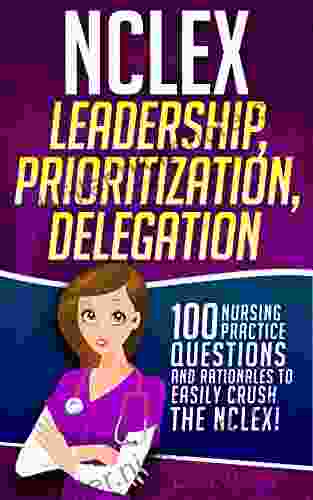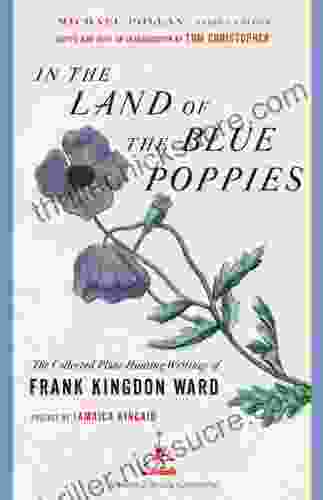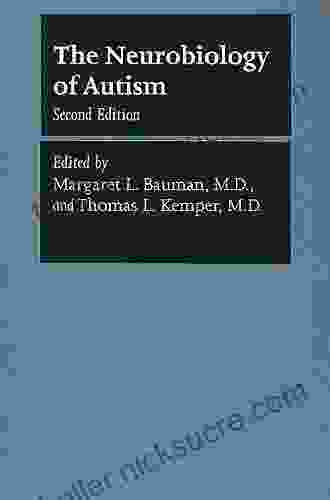The Neurobiology of Autism: A Comprehensive Overview from Johns Hopkins in Psychiatry and Neuroscience

Autism spectrum disorder (ASD) is a complex neurodevelopmental disorder that affects communication, social interaction, and behavior. It is estimated to affect 1 in 54 children in the United States. The exact cause of ASD is unknown, but it is believed to be caused by a combination of genetic and environmental factors.
4.5 out of 5
| Language | : | English |
| File size | : | 3298 KB |
| Text-to-Speech | : | Enabled |
| Screen Reader | : | Supported |
| Enhanced typesetting | : | Enabled |
| Print length | : | 419 pages |
In recent years, there has been a growing body of research on the neurobiology of ASD. This research has helped to identify some of the brain structures, genetic influences, and environmental factors that contribute to the disorder.
Brain Structures
Several brain structures have been found to be abnormal in people with ASD. These structures include the amygdala, the hippocampus, and the prefrontal cortex.
The amygdala is a small almond-shaped structure located in the medial temporal lobe. It is involved in the processing of emotions, particularly fear and anxiety. Studies have shown that the amygdala is smaller in people with ASD than in people without the disorder.
The hippocampus is a seahorse-shaped structure located in the medial temporal lobe. It is involved in the formation and retrieval of memories. Studies have shown that the hippocampus is smaller in people with ASD than in people without the disorder.
The prefrontal cortex is located in the front of the brain. It is involved in a variety of cognitive functions, including planning, decision-making, and social interaction. Studies have shown that the prefrontal cortex is less active in people with ASD than in people without the disorder.
Genetic Influences
ASD is a highly heritable disorder, meaning that it is passed down from parents to children. Studies have identified a number of genes that are associated with ASD. However, no single gene is responsible for the disorder.
The most common genetic risk factor for ASD is a mutation in the CHD8 gene. This gene is involved in regulating the expression of other genes. Mutations in the CHD8 gene can lead to changes in the structure and function of the brain.
Other genes that have been associated with ASD include the FMR1 gene, the MECP2 gene, and the TSC1 gene. These genes are involved in a variety of cellular processes, including protein synthesis, cell growth, and cell division. Mutations in these genes can lead to changes in the development and function of the brain.
Environmental Factors
In addition to genetic factors, environmental factors are also thought to play a role in the development of ASD. These factors include prenatal exposure to toxins, such as lead and mercury, and maternal stress during pregnancy.
Prenatal exposure to toxins can damage the developing brain. Lead and mercury are both neurotoxicants, which means that they can damage the nervous system. Exposure to these toxins can lead to a variety of neurological problems, including ASD.
Maternal stress during pregnancy can also increase the risk of ASD. Stress can release hormones that can cross the placenta and reach the developing fetus. These hormones can affect the development of the brain and increase the risk of ASD.
ASD is a complex neurodevelopmental disorder that is caused by a combination of genetic and environmental factors. Research on the neurobiology of ASD has helped to identify some of the brain structures, genetic influences, and environmental factors that contribute to the disorder. This research is ongoing and it is hoped that it will lead to new treatments and interventions for ASD.
4.5 out of 5
| Language | : | English |
| File size | : | 3298 KB |
| Text-to-Speech | : | Enabled |
| Screen Reader | : | Supported |
| Enhanced typesetting | : | Enabled |
| Print length | : | 419 pages |
Do you want to contribute by writing guest posts on this blog?
Please contact us and send us a resume of previous articles that you have written.
 Fiction
Fiction Non Fiction
Non Fiction Romance
Romance Mystery
Mystery Thriller
Thriller SciFi
SciFi Fantasy
Fantasy Horror
Horror Biography
Biography Selfhelp
Selfhelp Business
Business History
History Classics
Classics Poetry
Poetry Childrens
Childrens Young Adult
Young Adult Educational
Educational Cooking
Cooking Travel
Travel Lifestyle
Lifestyle Spirituality
Spirituality Health
Health Fitness
Fitness Technology
Technology Science
Science Arts
Arts Crafts
Crafts DIY
DIY Gardening
Gardening Petcare
Petcare Lewis Black
Lewis Black Michel Odent
Michel Odent Melanie Challenger
Melanie Challenger Nate Allen
Nate Allen Rob Vollman
Rob Vollman Tim Dunn
Tim Dunn Lisa Leake
Lisa Leake Michael Omi
Michael Omi John D Couch
John D Couch Natalia Ilyin
Natalia Ilyin Colleen Doyle Bryant
Colleen Doyle Bryant Pastor Ahyh
Pastor Ahyh Toni Weschler
Toni Weschler Joan Nathan
Joan Nathan Jackson T Markbrown
Jackson T Markbrown Karen Wilkinson
Karen Wilkinson S Connolly
S Connolly Elwyn Hartley Edwards
Elwyn Hartley Edwards Rachel Love Nuwer
Rachel Love Nuwer G E R Lloyd
G E R Lloyd Jhenah Telyndru
Jhenah Telyndru Larry A Yff
Larry A Yff Oded Galor
Oded Galor Smart Edition
Smart Edition F R Lifestyle
F R Lifestyle Mark Seemann
Mark Seemann Vicki Franz
Vicki Franz Rich Cohen
Rich Cohen Grete Waitz
Grete Waitz Xavier Wells
Xavier Wells Lily Raff Mccaulou
Lily Raff Mccaulou Roach Mary
Roach Mary David Jason
David Jason J R Mathews
J R Mathews Dan Jones
Dan Jones Stephen Hawking
Stephen Hawking Caitlin Flanagan
Caitlin Flanagan Arthur Scott Bailey
Arthur Scott Bailey Matt Morton
Matt Morton Hal R Varian
Hal R Varian Jules Wake
Jules Wake Harry Vardon
Harry Vardon Ryan M Cleckner
Ryan M Cleckner James Floyd Kelly
James Floyd Kelly Steve Guest
Steve Guest Mark Johnston
Mark Johnston Dr Lena Edwards
Dr Lena Edwards Kathleen Bartholomew
Kathleen Bartholomew Sarah Lamb
Sarah Lamb Kusha Karvandi
Kusha Karvandi John Mcenroe
John Mcenroe Malcolm Hebron
Malcolm Hebron James Zug
James Zug Manfred Theisen
Manfred Theisen J R Harris
J R Harris William Albert Robinson
William Albert Robinson Murray Shukyn
Murray Shukyn Robin Dunbar
Robin Dunbar Cal Ripken
Cal Ripken Steve Schwartz
Steve Schwartz Rob Collins
Rob Collins Don Brown
Don Brown Courtney Macavinta
Courtney Macavinta Daniel Bagur
Daniel Bagur Mitt Romney
Mitt Romney Bobbi Conner
Bobbi Conner William Trubridge
William Trubridge Elliot Davis
Elliot Davis Pat Manocchia
Pat Manocchia Tim Falconer
Tim Falconer Elizabeth Davis
Elizabeth Davis John Monaghan
John Monaghan Patricia Wooster
Patricia Wooster Keith Ryan Cartwright
Keith Ryan Cartwright Richard A Jaffe
Richard A Jaffe Mary Morrison
Mary Morrison Megan Whalen Turner
Megan Whalen Turner Ksenia K
Ksenia K Daniel Dell Uomo
Daniel Dell Uomo John A Fortunato
John A Fortunato Tadashi Yoshimura
Tadashi Yoshimura Steve Wiegand
Steve Wiegand Peter Wacht
Peter Wacht Kara Forney
Kara Forney Nicole Morales Lm Cpm
Nicole Morales Lm Cpm Joyce Harper
Joyce Harper Ivan Savov
Ivan Savov Nibedit Dey
Nibedit Dey Meg Cabot
Meg Cabot Cecilia Twinch
Cecilia Twinch Martin Wells
Martin Wells Florence Weiser
Florence Weiser Alex Horne
Alex Horne Brian Herne
Brian Herne Bonnie Henderson
Bonnie Henderson Lucia Guglielminetti
Lucia Guglielminetti Grace Mariana Rector
Grace Mariana Rector Joseph Ewing
Joseph Ewing Piero Ferrucci
Piero Ferrucci Joanne M Flood
Joanne M Flood Ji Kim
Ji Kim T J Tomasi
T J Tomasi Michael O Emerson
Michael O Emerson Jameswesley Rawles
Jameswesley Rawles Juliet Miller
Juliet Miller Ian Tuhovsky
Ian Tuhovsky Debra Fine
Debra Fine David Hoffman
David Hoffman Varg Freeborn
Varg Freeborn James A Whittaker
James A Whittaker Jacob Boehme
Jacob Boehme Erin Mckittrick
Erin Mckittrick Kathleen Taylor
Kathleen Taylor Christopher Clarey
Christopher Clarey Sunil Tanna
Sunil Tanna Renee Jain
Renee Jain Sam Sorbo
Sam Sorbo Ilchi Lee
Ilchi Lee Brogan Steele
Brogan Steele Brooks Blevins
Brooks Blevins Bret Stetka
Bret Stetka Peggy Kaye
Peggy Kaye Chukwuma Eleodimuo
Chukwuma Eleodimuo Jeanne Flavin
Jeanne Flavin Henry Worsley
Henry Worsley Lisa Scottoline
Lisa Scottoline T D Wilson
T D Wilson David Sinclair
David Sinclair Kate Mcmillan
Kate Mcmillan Richard Bass
Richard Bass Neil Postman
Neil Postman Shannon Warden
Shannon Warden John Fraser Hart
John Fraser Hart Claudia M Gold
Claudia M Gold Bruce A Fenderson
Bruce A Fenderson Linda Carter
Linda Carter Soong Chan Rah
Soong Chan Rah Genevieve Bardwell
Genevieve Bardwell Luis Angel Echeverria
Luis Angel Echeverria Adrienne Onofri
Adrienne Onofri Brian R King
Brian R King Scott Jurek
Scott Jurek Nicholas S Howe
Nicholas S Howe Dawna Markova
Dawna Markova Gerald L Schroeder
Gerald L Schroeder Ned Mcintosh
Ned Mcintosh Mark Lazerus
Mark Lazerus D S Malik
D S Malik Richard Post
Richard Post Thomas Malory
Thomas Malory Paul Weamer
Paul Weamer Jacqueline Houtman
Jacqueline Houtman John Jeffries Martin
John Jeffries Martin Ron Lieber
Ron Lieber Geoffrey Simpson
Geoffrey Simpson Matt Doeden
Matt Doeden Paul Simpson
Paul Simpson Daniel Vaughan
Daniel Vaughan Heyward Coleman
Heyward Coleman George Olsen
George Olsen Jodi Aman
Jodi Aman Steve Oakes
Steve Oakes Eric Michael
Eric Michael Cheryl Diamond
Cheryl Diamond Nick Heil
Nick Heil Nicholas Gallo
Nicholas Gallo Martin Odersky
Martin Odersky Charlie Francis
Charlie Francis Harold Gatty
Harold Gatty Lisa Druxman
Lisa Druxman Jason Brick
Jason Brick Mike Weatherstone
Mike Weatherstone Kicki Hansard
Kicki Hansard Michael Mason
Michael Mason Jennifer Block
Jennifer Block Brett Cohen
Brett Cohen Derek Blasberg
Derek Blasberg Cindy Margolis
Cindy Margolis George Case
George Case John Bradshaw
John Bradshaw John Wesson
John Wesson Paula Brackston
Paula Brackston William Shakespeare
William Shakespeare Einat L K
Einat L K Bruce Lee
Bruce Lee Chuanwei Li
Chuanwei Li Michael Ruhlman
Michael Ruhlman Christy Teglo
Christy Teglo Avery Faigenbaum
Avery Faigenbaum Della Ata Khoury
Della Ata Khoury James O Prochaska
James O Prochaska Clyde Soles
Clyde Soles Heather Rose
Heather Rose David Barrett
David Barrett Dava Sobel
Dava Sobel Matt Schifferle
Matt Schifferle Elsevier
Elsevier Leigh Pearson
Leigh Pearson Samuel Arbesman
Samuel Arbesman Claudia Gray
Claudia Gray Sonja Schwartzbach
Sonja Schwartzbach Richard Hingley
Richard Hingley Nehemia Gordon
Nehemia Gordon Grace Friedman
Grace Friedman Paul Carus
Paul Carus Patti Henry
Patti Henry Jonti Marks
Jonti Marks Janice L Raymond
Janice L Raymond John Major Jenkins
John Major Jenkins James D Tabor
James D Tabor O S Hawkins
O S Hawkins John M Taylor
John M Taylor David Mcclung
David Mcclung Wilborn Hampton
Wilborn Hampton Emilee Day
Emilee Day Laura A Jana
Laura A Jana Mike Adams
Mike Adams Robert Ullman
Robert Ullman Kerry Mcdonald
Kerry Mcdonald Kevin Alexander
Kevin Alexander Steven Hugg
Steven Hugg Michael Sullivan Iii
Michael Sullivan Iii Terence Tao
Terence Tao Scott Zimmerman
Scott Zimmerman Joe Grant
Joe Grant Ethan Bezos
Ethan Bezos Christine Brennan
Christine Brennan David Murray
David Murray Michael Masters
Michael Masters Jeremy J Baumberg
Jeremy J Baumberg Htebooks
Htebooks David Cannon
David Cannon Gjoko Muratovski
Gjoko Muratovski Kate S Martin
Kate S Martin Matt Parker
Matt Parker Lana Peek
Lana Peek Luis Preto
Luis Preto Dave Ramsey
Dave Ramsey Deborah Shouse
Deborah Shouse Adam Night
Adam Night Brian W Kernighan
Brian W Kernighan Tom Cunliffe
Tom Cunliffe Cal Pater
Cal Pater Diane Ravitch
Diane Ravitch Jay Asher
Jay Asher Celina Grace
Celina Grace D Enette Larson Meyer
D Enette Larson Meyer Megan Smolenyak
Megan Smolenyak J C Cervantes
J C Cervantes Jessica Minahan
Jessica Minahan Ernle Bradford
Ernle Bradford Jeremy Bradstreet
Jeremy Bradstreet Vincent W Davis
Vincent W Davis Keith Foskett
Keith Foskett Rich Osthoff
Rich Osthoff Rick Steves
Rick Steves Joanna Faber
Joanna Faber Zigzag English
Zigzag English Hiram Bingham
Hiram Bingham Brett Hull
Brett Hull Jason Sandy
Jason Sandy Kenneth Paul Rosenberg
Kenneth Paul Rosenberg Rob Coppolillo
Rob Coppolillo Grace Mccready
Grace Mccready Jim White
Jim White Brion Toss
Brion Toss Jennifer Comeaux
Jennifer Comeaux Jemar Tisby
Jemar Tisby Carol Newell
Carol Newell Marco Polo
Marco Polo Elizabeth Dupart
Elizabeth Dupart Rick J Scavetta
Rick J Scavetta Steven W Vannoy
Steven W Vannoy Richard Blais
Richard Blais Edith Hall
Edith Hall Tom M Apostol
Tom M Apostol Laurie A Watkins
Laurie A Watkins Colette Harris
Colette Harris Steven Shapin
Steven Shapin Fritjof Capra
Fritjof Capra James M Jones
James M Jones Sarah Kleck
Sarah Kleck Lee Mcintyre
Lee Mcintyre James Kaiser
James Kaiser Marguerite Henry
Marguerite Henry Jonathan H Turner
Jonathan H Turner Patrick Garbin
Patrick Garbin Steve Williams
Steve Williams Stephen Wood
Stephen Wood Natalia Rojas
Natalia Rojas Calvin Trillin
Calvin Trillin Lucy Hopping
Lucy Hopping David Barrie
David Barrie Ann Imig
Ann Imig Clayton King
Clayton King Jp Kriya
Jp Kriya Santari Green
Santari Green Steven Cross
Steven Cross Peggy Tharpe
Peggy Tharpe Jackie Freeman
Jackie Freeman Nadim Saad
Nadim Saad Bruce Macdonald
Bruce Macdonald Jay H Lefkowitch
Jay H Lefkowitch Susan F Paterno
Susan F Paterno Carol Walters
Carol Walters Nachole Johnson
Nachole Johnson Kira Breed Wrisley
Kira Breed Wrisley Douglas Wood
Douglas Wood Sriman Sharma
Sriman Sharma Neil S Jacobson
Neil S Jacobson Mohammad F Anwar
Mohammad F Anwar Denise Long
Denise Long Charles Todd
Charles Todd Loyd Ellis
Loyd Ellis Jd Tanner
Jd Tanner Brienne Murk
Brienne Murk Sandy Jones
Sandy Jones James Dean
James Dean Brian Gewirtz
Brian Gewirtz Carol Kaesuk Yoon
Carol Kaesuk Yoon Bernard Darwin
Bernard Darwin James Miller
James Miller Miguel Crespo
Miguel Crespo Julie Cangialosi
Julie Cangialosi Jez Cajiao
Jez Cajiao Nora Roberts
Nora Roberts Cpt Exam Prep Team
Cpt Exam Prep Team Guido W Imbens
Guido W Imbens David Schoem
David Schoem Pittacus Lore
Pittacus Lore Molly Caldwell Crosby
Molly Caldwell Crosby Dinesh Kumar Goyal
Dinesh Kumar Goyal Jean Nayar
Jean Nayar Phyllis Books
Phyllis Books Lenore Skenazy
Lenore Skenazy Lucinda Scala Quinn
Lucinda Scala Quinn Kalynn Bayron
Kalynn Bayron Kyle Rohrig
Kyle Rohrig Eze Ugbor
Eze Ugbor Jonathan Grix
Jonathan Grix Mark William
Mark William Gene Kritsky
Gene Kritsky Mary Strand
Mary Strand Eric R Dodge
Eric R Dodge Megan Kelley Hall
Megan Kelley Hall Emily Lauren Dick
Emily Lauren Dick Michael Barkun
Michael Barkun David Hatcher Childress
David Hatcher Childress Ted Franklin Belue
Ted Franklin Belue Sujit Sivasundaram
Sujit Sivasundaram Patrick Carnes
Patrick Carnes Thomas A Jacobs
Thomas A Jacobs Carlo Zen
Carlo Zen Robert Wright
Robert Wright Khalid Khashoggi
Khalid Khashoggi Collins O Onwe
Collins O Onwe Catherine Shainberg
Catherine Shainberg F Brent Neal
F Brent Neal Judith A Owens
Judith A Owens Howtodressage
Howtodressage Dan Washburn
Dan Washburn Joel Ingersoll
Joel Ingersoll Sara Gaviria
Sara Gaviria Jane Albert
Jane Albert Shayla Black
Shayla Black Sara Elliott Price
Sara Elliott Price Frederick L Coolidge
Frederick L Coolidge Kathleen Cushman
Kathleen Cushman Brittany Cavallaro
Brittany Cavallaro Cassandra Overby
Cassandra Overby Nathan Halberstadt
Nathan Halberstadt Inger Mewburn
Inger Mewburn Dr Alison Dibarto Goggin
Dr Alison Dibarto Goggin Mike Eastman
Mike Eastman Matt Wastradowski
Matt Wastradowski Guy P Harrison
Guy P Harrison Genie Reads
Genie Reads Ursula Hackett
Ursula Hackett Thao Te
Thao Te Megan Davidson
Megan Davidson Michael Shaw
Michael Shaw Stuart Woods
Stuart Woods Estelle Dautry
Estelle Dautry Mahmood Mamdani
Mahmood Mamdani Nicholas Bjorn
Nicholas Bjorn Chuck Callaway
Chuck Callaway Peter Zuckerman
Peter Zuckerman Sean Michael Wilson
Sean Michael Wilson Jp Lepeley
Jp Lepeley Kent Hoffman
Kent Hoffman Penny Alexander
Penny Alexander Marc Bona
Marc Bona Esther Hicks
Esther Hicks Roshani Chokshi
Roshani Chokshi Scott Haines
Scott Haines Matthew Desmond
Matthew Desmond Scott Hawthorn
Scott Hawthorn Colleen Craig
Colleen Craig Melinda Tankard Reist
Melinda Tankard Reist Lindsey Schlessinger
Lindsey Schlessinger Salima Ikram
Salima Ikram Porter Shimer
Porter Shimer Samantha Michaels
Samantha Michaels Eric C Lindstrom
Eric C Lindstrom John Mclachlan
John Mclachlan Mick Conefrey
Mick Conefrey Dr Monique Thompson Dha Lpc
Dr Monique Thompson Dha Lpc Melissa Trevathan
Melissa Trevathan Martin A Lee
Martin A Lee Karl F Kuhn
Karl F Kuhn Worth Books
Worth Books J Wayne Fears
J Wayne Fears Caitlyn Dare
Caitlyn Dare David M Ewalt
David M Ewalt Gustav Meyrink
Gustav Meyrink Maurice Herzog
Maurice Herzog John Cooper
John Cooper Samuel Greenberg
Samuel Greenberg Don L Gates
Don L Gates Patty Wipfler
Patty Wipfler Nancy Boyd Franklin
Nancy Boyd Franklin Steven Verrier
Steven Verrier Deepak Chopra
Deepak Chopra E L Konigsburg
E L Konigsburg St Teresa Of Avila
St Teresa Of Avila Mark J Ferrari
Mark J Ferrari Rachel Mcgrath
Rachel Mcgrath Bryan Berard
Bryan Berard Marc J Reilly
Marc J Reilly Dusan Petkovic
Dusan Petkovic Garrett Redfield
Garrett Redfield Breanna Hayse
Breanna Hayse Kaylene Yoder
Kaylene Yoder Iwan Rhys Morus
Iwan Rhys Morus Matt Davids
Matt Davids M A Hayat
M A Hayat Joseph Burbridge
Joseph Burbridge Curtis Wilkie
Curtis Wilkie Sandra M Nettina
Sandra M Nettina Mariana Monteiro
Mariana Monteiro Peter Allison
Peter Allison Brian Reddington
Brian Reddington William Souder
William Souder Doug Peacock
Doug Peacock 1st Ed 2018 Edition Kindle Edition
1st Ed 2018 Edition Kindle Edition Rosalyn Sheehy
Rosalyn Sheehy Joanna Sayago Golub
Joanna Sayago Golub Krishna Godhania
Krishna Godhania David Wootton
David Wootton Joanna Philbin
Joanna Philbin Gabriel F Federico
Gabriel F Federico Jimmie Holland
Jimmie Holland Scott Reed
Scott Reed Frederick Grinnell
Frederick Grinnell Timothy A Sisemore
Timothy A Sisemore Gerson S Sher
Gerson S Sher Martin Sternstein
Martin Sternstein Gerald R Allen
Gerald R Allen Paul Farmer
Paul Farmer Dave Cutcher
Dave Cutcher Tobe Melora Correal
Tobe Melora Correal Mitchel P Roth
Mitchel P Roth Mark Powell
Mark Powell Milne Cc Pocock
Milne Cc Pocock Inge Bell
Inge Bell Charles Wilson
Charles Wilson Steven Trustrum
Steven Trustrum Eduardo Montano
Eduardo Montano Helen Zee
Helen Zee Leslie Valiant
Leslie Valiant Diana J Mason
Diana J Mason Victor A Bloomfield
Victor A Bloomfield Jeanne Ellis Ormrod
Jeanne Ellis Ormrod David Hackett Fischer
David Hackett Fischer Danny Staple
Danny Staple David Levithan
David Levithan John Connelly
John Connelly Warren Hansen
Warren Hansen Judy H Wright
Judy H Wright Jeannette De Wyze
Jeannette De Wyze Derick Lugo
Derick Lugo Michael A Tompkins
Michael A Tompkins Dan Fullerton
Dan Fullerton J F James
J F James Karen Ward Mahar
Karen Ward Mahar Seb Falk
Seb Falk Pedro Sarmiento De Gamboa
Pedro Sarmiento De Gamboa Kazumi Tabata
Kazumi Tabata Mary Heffernan
Mary Heffernan Dr Nanhee Byrnes
Dr Nanhee Byrnes Roman Gurbanov
Roman Gurbanov Maggie Dallen
Maggie Dallen Mark Howard
Mark Howard Stephanie Perkins
Stephanie Perkins Phil Williams
Phil Williams P A Johnson
P A Johnson Brian Noyes
Brian Noyes Brian Everitt
Brian Everitt Sue Wieger
Sue Wieger Loan Le
Loan Le Paula Span
Paula Span Rory D Nelson
Rory D Nelson Janae M Robinson
Janae M Robinson D Levesque
D Levesque Steven Emanuel
Steven Emanuel E G Richards
E G Richards Ronald M Rapee
Ronald M Rapee Colleen Houck
Colleen Houck Karen E Mcconnell
Karen E Mcconnell Emil Frlez
Emil Frlez Phillip Stephen Schulz
Phillip Stephen Schulz Wil Fleming
Wil Fleming Christopher Ketcham
Christopher Ketcham Alan D Moore
Alan D Moore David Flanagan
David Flanagan John Moren
John Moren Lori Lyons
Lori Lyons Douglas R Hofstadter
Douglas R Hofstadter Rahul Jandial
Rahul Jandial Masaaki Kijima
Masaaki Kijima Michael Sean Comerford
Michael Sean Comerford Steve Bromley
Steve Bromley Carol Dawson
Carol Dawson Trish Kuffner
Trish Kuffner Lucas Chancel
Lucas Chancel Cecelia Ahern
Cecelia Ahern Harry Bauld
Harry Bauld Lukas M Verburgt
Lukas M Verburgt Kelle James
Kelle James Maria Sharapova
Maria Sharapova Keith Ammann
Keith Ammann Lee Alan Dugatkin
Lee Alan Dugatkin Kevin Marx
Kevin Marx Jaime Flowers
Jaime Flowers Brian Kilmeade
Brian Kilmeade Joyce Bas
Joyce Bas Stephanie Sarkis
Stephanie Sarkis Jeannie Burlowski
Jeannie Burlowski Jacques Vallee
Jacques Vallee Dr Faith G Harper
Dr Faith G Harper Damien Cox
Damien Cox Kindle Edition
Kindle Edition Tyler Hamilton
Tyler Hamilton Chase Hassen
Chase Hassen Daniel Bergner
Daniel Bergner Brett Stewart
Brett Stewart Richard Kasper
Richard Kasper
Light bulbAdvertise smarter! Our strategic ad space ensures maximum exposure. Reserve your spot today!

 Eli BrooksUnveiling the Dark History and Notorious Deeds of the Ruin Red Ridge Sinners...
Eli BrooksUnveiling the Dark History and Notorious Deeds of the Ruin Red Ridge Sinners...
 Fyodor DostoevskyPractical Guide to UK Higher Education: Humanities, Social Sciences, and...
Fyodor DostoevskyPractical Guide to UK Higher Education: Humanities, Social Sciences, and... Wayne CarterFollow ·9.3k
Wayne CarterFollow ·9.3k Paul ReedFollow ·10.4k
Paul ReedFollow ·10.4k Bo CoxFollow ·17.9k
Bo CoxFollow ·17.9k Kyle PowellFollow ·3.3k
Kyle PowellFollow ·3.3k Austin FordFollow ·15.7k
Austin FordFollow ·15.7k Rudyard KiplingFollow ·18k
Rudyard KiplingFollow ·18k Joseph ConradFollow ·7.9k
Joseph ConradFollow ·7.9k Percy Bysshe ShelleyFollow ·13.7k
Percy Bysshe ShelleyFollow ·13.7k

 Guillermo Blair
Guillermo Blair2nd Edition Revised And Expanded 2024: A Comprehensive...
The 2nd Edition Revised...

 Ronald Simmons
Ronald SimmonsDreaming of Ocean Cruising: A Voyage into Tranquility and...
For those seeking a respite from the mundane...

 Darren Nelson
Darren Nelson100 Nursing Practice Questions with Rationales to...
The NCLEX exam is a challenging but...

 Rex Hayes
Rex HayesMastering Bodyweight Training for Martial Arts: A...
For martial...

 Dillon Hayes
Dillon HayesIn The Land Of The Blue Poppies: A Literary Journey to...
Prologue: A Tapestry of...

 Eliot Foster
Eliot FosterCollege University Writing Super Review Flash Card Books:...
College University...
4.5 out of 5
| Language | : | English |
| File size | : | 3298 KB |
| Text-to-Speech | : | Enabled |
| Screen Reader | : | Supported |
| Enhanced typesetting | : | Enabled |
| Print length | : | 419 pages |








